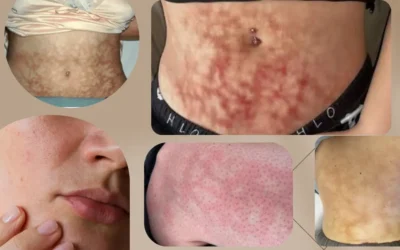A consistent and well-crafted skin care routine is the foundation for achieving and maintaining healthy, radiant skin. In this comprehensive guide, we will explore the essential steps of an effective skin care routine.
Whether you’re a beginner looking to establish a solid regimen or seeking to optimize your existing routine, this article will provide valuable insights, tips, and product recommendations to help you on your journey to a glowing complexion.
Let’s dive into the secrets of a successful skin care routine!
Step 1: Cleansing – Purify Your Canvas
Cleansing is the first and most crucial step in any skin care routine. It helps remove dirt, impurities, and excess oil, allowing your skin to breathe and absorb the benefits of subsequent skincare products. Here’s how to cleanse effectively:
Choose the Right Cleanser: Select a gentle cleanser that suits your skin type. For dry or sensitive skin, opt for a hydrating or creamy cleanser. For oily or acne-prone skin, consider a foaming or gel-based cleanser that helps control oil and unclog pores.
Wet Your Face: Splash your face with lukewarm water to dampen the skin before applying the cleanser.
Apply Cleanser: Take a small amount of cleanser and gently massage it onto your face using circular motions. Pay attention to areas prone to oiliness or makeup buildup.
Rinse Thoroughly: Rinse your face with lukewarm water until all traces of cleanser are removed. Pat your skin dry with a clean towel.
Step 2: Toning – Restore pH Balance
Toning is an often overlooked but important step in a comprehensive skincare routine. It helps restore the skin’s pH balance, minimize the appearance of pores, and prep the skin for better absorption of subsequent products.
Follow these steps for an effective toning process:
Select a Suitable Toner: Choose a toner that is alcohol-free and gentle on the skin. Look for ingredients like witch hazel, rosewater, or aloe vera, known for their soothing and balancing properties.
Apply the Toner: Pour a small amount of toner onto a cotton pad or your fingertips and gently pat or swipe it across your face and neck. Avoid the eye area.
Let it Absorb: Give the toner a few moments to absorb into your skin before moving on to the next step.
Step 3: Treatment – Address Specific Concerns
This step allows you to target specific skin concerns, such as acne, hyperpigmentation, or signs of aging. Treatments come in various forms, including serums, spot treatments, or face masks.
Here’s how to incorporate treatments into your routine:
Identify Your Concern: Determine the specific issue you want to address, such as acne, dark spots, or fine lines.
Choose an Appropriate Treatment: Select a treatment product that is formulated to tackle your specific concern. For example, if you have acne, choose a spot treatment containing ingredients like salicylic acid or benzoyl peroxide.
Apply as Directed: Follow the instructions provided with the treatment product for application. Generally, you’ll apply a small amount to the affected areas or all over your face, depending on the product.
Allow Absorption: Give the treatment time to absorb into your skin before moving on to the next step.
Step 4: Moisturizing – Hydrate and Nourish
Moisturizing is an essential step to replenish hydration, nourish the skin, and maintain a healthy moisture barrier. Follow these steps to ensure optimal moisturization:
Choose the Right Moisturizer: Select a moisturizer suited to your skin type and concerns. Opt for lightweight, non-comedogenic formulas for oily or acne-prone skin and richer creams for dry or mature skin.
Apply to Damp Skin: After cleansing and toning, apply your moisturizer to slightly damp skin. This helps seal in moisture and enhance absorption.
Massage Gently: Take a small amount of moisturizer and gently massage it into your face and neck using upward, circular motions. Don’t forget to include the delicate skin around your eyes.
Sun Protection: If your moisturizer doesn’t contain SPF, it’s crucial to apply a broad-spectrum sunscreen as the final step in your daytime routine.
Step 5: Sun Protection – Shield from Harmful Rays
Protecting your skin from the sun’s damaging UV rays is vital for preventing premature aging, sunburns, and skin cancer. Follow these guidelines for proper sun protection:
Choose a Broad-Spectrum Sunscreen: Select a sunscreen with a high SPF (at least 30) and broad-spectrum protection to shield against both UVA and UVB rays.
Apply Generously: Dispense an ample amount of sunscreen and apply it evenly across your face, neck, and other exposed areas of your body. Don’t forget commonly neglected areas like the ears and back of the neck.
Reapply Regularly: Reapply sunscreen every two hours, or more frequently if you’ve been swimming or sweating heavily. Remember, sunscreen is essential even on cloudy days.
Step 6: Incorporating Face Masks – Boost Your Skin’s Health
Face masks offer an additional boost to your skin care routine by providing targeted treatments and addressing specific concerns. Consider adding the following types of face masks to your routine:
Hydrating Masks: These masks infuse your skin with moisture and help combat dryness. Look for ingredients like hyaluronic acid, aloe vera, or glycerin for intense hydration.
Exfoliating Masks: Exfoliating masks help remove dead skin cells, unclog pores, and promote a brighter complexion. Ingredients like enzymes, clay, or alpha-hydroxy acids (AHAs) can effectively exfoliate the skin.
Purifying Masks: If you have oily or acne-prone skin, purifying masks can help control excess oil, minimize breakouts, and refine the appearance of pores. Look for ingredients like charcoal, clay, or tea tree oil.
Brightening Masks: These masks are designed to improve skin tone and diminish the appearance of dark spots or hyperpigmentation. Ingredients like vitamin C, niacinamide, or licorice extract are known for their brightening properties.
Soothing Masks: If you have sensitive or irritated skin, soothing masks can help calm inflammation and provide relief. Ingredients like chamomile, aloe vera, or green tea extract have soothing properties.
Apply face masks after cleansing and toning, and follow the instructions provided with the specific mask for application time and frequency.
Step 7: Nighttime Skincare – Maximize Skin Repair
Nighttime skincare routines play a crucial role in allowing your skin to repair and rejuvenate while you sleep. Consider the following steps for an effective nighttime routine:
Double Cleansing: Start by using an oil-based cleanser to remove makeup, sunscreen, and excess oil. Follow with a gentle water-based cleanser to cleanse the skin thoroughly.
Serums and Treatments: Apply targeted serums or treatments that focus on specific concerns like anti-aging, brightening, or hydration. Look for ingredients like retinol, vitamin C, or hyaluronic acid.
Night Cream or Moisturizer: Choose a nourishing night cream or moisturizer that provides intense hydration and supports the skin’s natural repair processes. Ingredients like peptides, antioxidants, or ceramides can be beneficial.
Eye Cream: Apply a specialized eye cream or gel to target concerns like fine lines, dark circles, or puffiness. Gently pat the product around the eye area using your ring finger.
Lip Treatment: Don’t forget to give your lips some extra care by applying a hydrating lip balm or treatment before bed.
Step 8: Lifestyle Factors for Healthy Skin
In addition to a consistent skincare routine, certain lifestyle factors can significantly impact the health and clarity of your skin. Consider the following tips:
Hydration: Drink an adequate amount of water daily to keep your skin hydrated from within. Aim for at least 8 glasses of water a day.
Balanced Diet: Consume a nutrient-rich diet that includes plenty of fruits, vegetables, whole grains, and lean proteins. Antioxidant-rich foods like berries and leafy greens can help support healthy skin.
Manage Stress: Chronic stress can contribute to skin issues. Find healthy ways to manage stress, such as practicing mindfulness, exercising, or engaging in hobbies.
Quality Sleep: Ensure you get enough quality sleep each night. During sleep, your skin undergoes repair and regeneration processes, contributing to a healthier complexion.
Sun Protection: Even if you follow a nighttime routine, it’s important to protect your skin from the sun during the day. Apply sunscreen daily, seek shade when the sun is strongest, and wear protective clothing.
Remember, consistency and patience are key when it comes to achieving clear and healthy skin. Tailor your routine to your specific needs and concerns, and monitor how your skin responds to different products and treatments.
By following a comprehensive skincare routine and incorporating healthy lifestyle habits, you can achieve the clear, radiant skin you desire.
Bonus Tips and Tricks for a Flawless Skin Care Routine
Exfoliation: Incorporate gentle exfoliation into your routine once or twice a week to slough off dead skin cells and promote cell turnover.
Choose a physical scrub or a chemical exfoliant like alpha-hydroxy acids (AHAs) or beta-hydroxy acids (BHAs).
Eye Care: Don’t neglect the delicate skin around your eyes. Invest in a separate eye cream or gel to address concerns like dark circles, puffiness, or fine lines.
Lip Care: Keep your lips soft and supple by applying a nourishing lip balm or treatment. Look for ingredients like shea butter or hyaluronic acid.
Consistency is Key: Stick to your routine consistently to reap the benefits. Give your skin time to adjust to new products and monitor how your skin responds. Adjust as needed.
Conclusion
Establishing a well-rounded and consistent skin care routine is essential for achieving and maintaining healthy, radiant skin. By following the essential steps of cleansing, toning, treating, moisturizing, and protecting, you can provide your skin with the care it deserves.
Remember, everyone’s skin is unique, so it’s important to tailor your routine to your specific needs and concerns. With patience, dedication, and the right products, you’ll be on your way to a healthier, more beautiful complexion.


